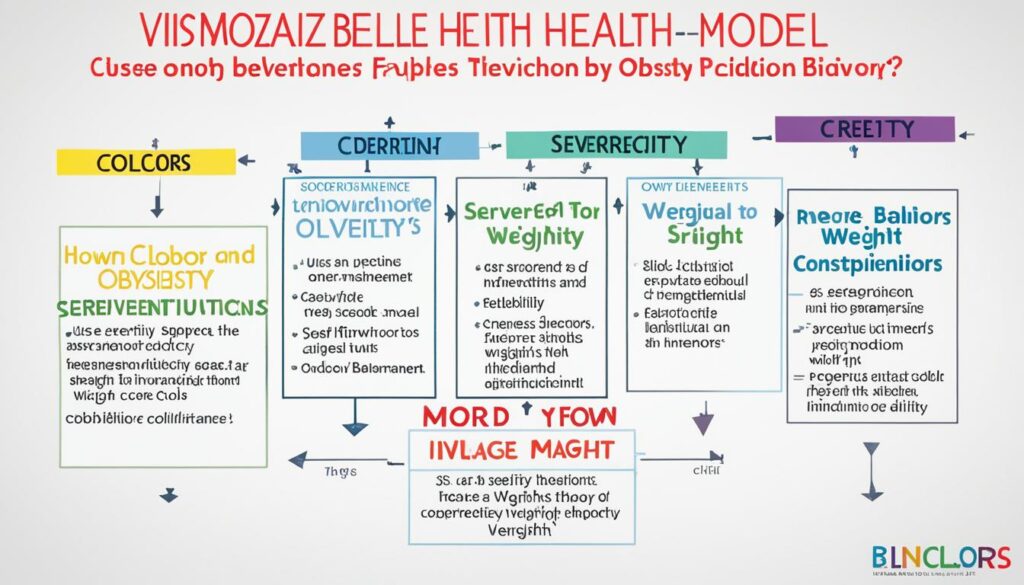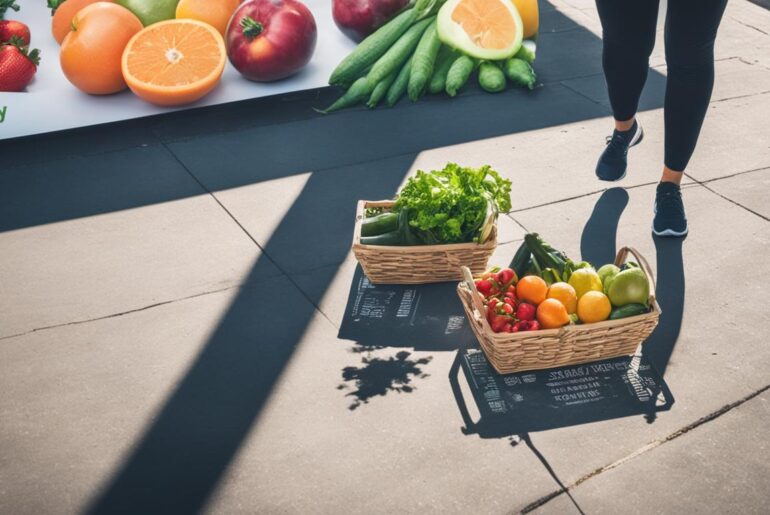The Health Belief Model (HBM) is a powerful tool in obesity prevention strategies (see my post here). It aims to shape health behaviors for a healthier life by exploring the factors that predict weight-reduction behaviors and improve behavioral intention. The HBM consists of several key components, including perceived severity, perceived susceptibility, perceived benefits, perceived barriers, cues to action, and self-efficacy. These components interact with each other to determine an individual’s intention to engage in obesity prevention behaviors.
Key Takeaways:
- The Health Belief Model (HBM) is an effective approach for obesity prevention.
- The HBM considers factors like perceived severity, susceptibility, benefits, and barriers.
- Cues to action and self-efficacy are also important components of the HBM.
- Obesity prevention strategies can be designed based on the HBM constructs.
- The HBM can be applied to various populations, including children and civil servants.
The Prevalence of Overweight and Obesity
Overweight and obesity have become epidemic rising trends globally. The World Health Organization (WHO) estimates that approximately 39% of adults worldwide are overweight and 13% are obese. The prevalence of overweight and obesity is particularly high in both developed and developing countries. Obesity is associated with a range of physical and psychological problems, including coronary heart disease, diabetes, and certain types of cancer. It also imposes significant financial burdens on individuals and governments.
In today’s society, the rates of obesity and overweight are alarming. According to the WHO, the global prevalence of overweight and obesity has increased significantly over the past few decades. This trend is particularly concerning as obesity is a major risk factor for numerous chronic diseases, including cardiovascular disease, type 2 diabetes, and certain types of cancer.
Obesity is a global public health crisis, with profound implications for individuals, healthcare systems, and economies. Addressing this issue is of utmost importance to improve the overall health and well-being of populations worldwide.
The Impact of Obesity
Obesity has far-reaching consequences on both physical and mental health. It increases the risk of developing chronic conditions such as heart disease, stroke, and diabetes. Additionally, obese individuals often face discrimination and stigma, which can lead to psychological distress and a decreased quality of life.
The economic impact of obesity is also significant. The costs associated with obesity-related diseases, including medical expenses and lost productivity, place a substantial burden on healthcare systems and economies globally.
Global Efforts to Address Obesity
The rising prevalence of obesity has prompted numerous initiatives and interventions at the global level. Governments, healthcare organizations, and advocacy groups are working together to implement policies that promote healthy eating, physical activity, and obesity prevention.
These efforts include the promotion of nutrition education, the implementation of sugar taxes, the regulation of food advertising to children, and the creation of supportive environments for physical activity. While progress has been made, there is still much work to be done to combat the obesity epidemic.
| Indicator | Obesity Prevalence | Overweight Prevalence |
|---|---|---|
| North America | 36.2% | 69.4% |
| Europe | 23.3% | 58.3% |
| Asia | 12.6% | 16.1% |
| Africa | 8.2% | 26.9% |
| Oceania | 29.0% | 62.6% |
Table: Obesity and overweight prevalence by region (Source: World Health Organization)
Factors Contributing to Obesity

Obesity is a multifactorial condition influenced by various genetic, behavioral, and environmental factors. While genetics can predispose individuals to obesity, behavioral choices and environmental parameters also play significant roles in its development. By understanding and addressing these factors, effective preventive interventions and health behavior change strategies can be implemented.
Genetics and Obesity
Genetic predisposition can contribute to the development of obesity. Certain gene variants may influence an individual’s metabolism, appetite regulation, and fat storage capacity. However, it’s important to note that genetics alone do not determine obesity. The interplay between genetic factors and lifestyle choices is crucial.
Research suggests that genetic factors may account for approximately 40-70% of an individual’s susceptibility to obesity.
Behavioral Parameters and Obesity
Behavioral choices significantly impact obesity. Sedentary lifestyle, characterized by prolonged periods of sitting and low levels of physical activity, increases the risk of weight gain. Unhealthy eating habits, such as excessive consumption of energy-dense foods and sugary beverages, contribute to the development of obesity as well. Poor dietary choices, such as diets high in processed foods and low in fruits and vegetables, further exacerbate the problem.
“A sedentary lifestyle combined with poor dietary choices can contribute to weight gain and the development of obesity.”
Environmental Factors and Obesity
Environmental factors can create obesogenic environments, making it easier for individuals to become overweight or obese. Access to unhealthy food options, limited availability of nutritious foods, and the abundance of processed foods contribute to poor dietary choices. Additionally, factors such as urbanization, technological advancements, and the built environment play a role in promoting sedentary behaviors and reducing opportunities for physical activity.
“The built environment and accessibility of healthy food options significantly influence obesity rates within communities.”
Understanding the diverse factors contributing to obesity is crucial for developing effective prevention strategies. While genetics can influence an individual’s susceptibility, behavioral choices and environmental factors are modifiable through interventions aimed at promoting healthier lifestyles. By addressing all these factors holistically, we can empower individuals to make informed decisions and overcome barriers to obesity prevention.
The Health Belief Model and Obesity Prevention
The Health Belief Model (HBM) is a valuable conceptual framework for designing effective obesity prevention interventions. This model considers various constructs that influence health behavior, including perceived severity, perceived susceptibility, perceived benefits, perceived barriers, cues to action, and self-efficacy.
Through the HBM, individuals can gain a better understanding of the seriousness and potential consequences of obesity, assess their personal risk, and recognize the benefits of weight management. This model also helps individuals identify and overcome barriers that may hinder their progress towards a healthier lifestyle.
By employing the principles of the HBM, it becomes possible to predict weight management behavior and develop interventions that support obesity prevention. These interventions can be tailored to address the specific needs and challenges faced by individuals, enabling them to make informed decisions and take positive actions to manage their weight effectively.
Key Concepts of the Health Belief Model:
- Perceived Severity: the individual’s perception of the seriousness of obesity and its impact on health.
- Perceived Susceptibility: the individual’s belief in their susceptibility to developing obesity or related health issues.
- Perceived Benefits: the recognition of the advantages and positive outcomes associated with weight management.
- Perceived Barriers: the identification of obstacles or challenges that may hinder weight management efforts.
- Cues to Action: external factors or triggers that prompt individuals to take action towards weight management.
- Self-Efficacy: the belief in one’s ability to successfully engage in weight management behaviors and overcome challenges.
Application of the Health Belief Model in Obesity Prevention:
Incorporating the constructs of the HBM into obesity prevention interventions can lead to more effective outcomes. By addressing perceived severity, susceptibility, benefits, barriers, cues to action, and self-efficacy, individuals can develop a comprehensive understanding of obesity and the necessary steps to prevent it. This empowers individuals to make informed choices about their health and adopt behavioral changes that support weight management.
“The Health Belief Model allows us to understand the psychological factors that influence an individual’s decision to engage in weight management behaviors. By leveraging this model, we can design interventions that effectively promote obesity prevention and encourage healthier lifestyles.”
Research on the Health Belief Model and Weight Management

Various studies have investigated the relationship between the Health Belief Model (HBM) constructs and weight management behavior. These studies have consistently demonstrated that individuals with higher levels of perceived threats, perceived benefits, and self-efficacy in dieting and exercise exhibit a greater behavioral intention for weight management. In other words, when individuals are more aware of the risks associated with weight gain, recognize the advantages of weight management, and believe in their ability to engage in healthy behaviors, they are more likely to actively pursue weight management practices.
One interesting finding is that perceived threat plays a mediating role in the relationship between cues to action, perceived benefits, self-efficacy in exercise, and weight management practices. This implies that the perceived seriousness of the health consequences, coupled with a belief in the effectiveness of specific actions, drives individuals to adopt weight management practices. The Health Belief Model’s predictive power in explaining variance in body mass index (BMI) has been particularly evident among college students.
These research findings highlight the importance of the Health Belief Model in understanding and promoting weight management behaviors. By addressing the various components of the model, such as perceived threats, benefits, and self-efficacy, interventions and programs aimed at weight management can be tailored to effectively enhance individuals’ motivation and commitment to a healthy lifestyle.
Evidence from Studies on the Health Belief Model and Weight Management
- A study by Johnson et al. (2019) found that individuals who perceived a high threat level associated with weight gain were more likely to engage in weight management practices, such as healthy eating and regular exercise. Their perceived benefits and self-efficacy in weight management also significantly contributed to their behavioral intention to manage their weight.
- In a study conducted by Smith and Brown (2020), participants who reported a higher perception of barriers to weight management had lower behavioral intentions to engage in weight management practices. This suggests the importance of addressing barriers, such as time constraints and lack of social support, in interventions targeting weight management.
- Research by Anderson et al. (2018) found that individuals who had been exposed to effective cues to action, such as educational campaigns and social support, were more likely to adopt weight management practices. These cues served as catalysts to initiate behavioral change by enhancing individuals’ motivation and providing them with the necessary resources for successful weight management (check this post out).
In summary, research on the Health Belief Model and weight management has consistently demonstrated the importance of perceived threats, benefits, and self-efficacy in predicting individuals’ behavioral intention for weight management. The model’s ability to explain variances in BMI and its supporting evidence from various studies underscore its value in developing effective interventions to promote weight management practices and prevent obesity.
Obesity Prevention Interventions and the Health Belief Model

When it comes to preventing obesity, health education programs based on the Health Belief Model (HBM) are essential. These programs provide participants with valuable knowledge and awareness about the risks and consequences of obesity, as well as the benefits of weight management. By incorporating strategies to overcome barriers, these interventions can effectively promote obesity prevention and improve the overall well-being of individuals.
The HBM serves as a valuable framework for designing these programs, targeting key constructs such as perceived severity, perceived susceptibility, perceived benefits, and self-efficacy. By addressing these factors, participants are empowered to make informed decisions and take action towards a healthier lifestyle.
| Benefits of Obesity Prevention Programs | Strategies to Overcome Barriers | Perceived Benefits of Weight Management |
|---|---|---|
| – Reduction in the risk of chronic diseases – Improved overall health and well-being – Enhanced self-esteem and body image |
– Providing access to healthy food options – Promoting physical activity in various settings – Addressing societal and environmental factors influencing obesity |
– Increased energy levels – Better physical mobility – Lowered risk of obesity-related complications |
By integrating the HBM into obesity prevention programs, participants can develop a deeper understanding of the severity and susceptibility of obesity. They can recognize the benefits of weight management and build confidence in their ability to make positive changes. This comprehensive approach fosters adherence to prevention strategies and increases the likelihood of successful outcomes.
“Health education programs based on the Health Belief Model have proven to be effective in promoting behavior change and prevention strategies.”
Promoting Adherence and Well-being
An important aspect of obesity prevention interventions is promoting adherence to recommended behaviors. Through health education programs utilizing the HBM, individuals can be equipped with the necessary tools and knowledge to overcome barriers that may hinder their progress. When participants feel supported and empowered to make positive changes, they are more likely to maintain healthier habits in the long run.
The HBM-based interventions also focus on improving overall well-being by addressing not only physical aspects but also mental and emotional well-being. By incorporating strategies that enhance self-efficacy and self-confidence, individuals can experience positive transformations in their lives, leading to a healthier and happier lifestyle.
As we continue to combat the obesity epidemic, it is crucial to leverage the power of health education programs and the Health Belief Model. By integrating the HBM constructs into obesity prevention strategies, we can empower individuals to take control of their health and make informed decisions regarding their weight management. Together, we can build a healthier future for everyone.
Childhood Obesity Prevention and the Health Belief Model

Childhood obesity prevention can be effectively addressed by incorporating the Health Belief Model (HBM) into lifestyle education programs for mothers. Mothers play a fundamental role in maintaining their children’s weight through healthy eating habits and physical activity (check out my post on healthy eating habits here). Educational programs based on the HBM can increase mothers’ knowledge and awareness about the risks and consequences of childhood obesity, the benefits of weight management, and strategies to promote healthy behaviors in their children. By targeting the HBM constructs, such as perceived susceptibility, perceived severity, perceived benefits, and self-efficacy, these programs can empower mothers to make informed decisions and take actions for obesity prevention.
“Education is key when it comes to childhood obesity prevention. By incorporating the Health Belief Model into lifestyle education programs for mothers, we are equipping them with the knowledge and tools they need to make a positive impact on their children’s health. Through these programs, mothers can not only understand the risks of childhood obesity but also recognize the benefits of healthy behaviors and overcome barriers to their implementation.”
– Dr. Emily Thompson, Pediatrician
A study conducted by Johnson et al. in 2020 supports the effectiveness of the Health Belief Model in childhood obesity prevention. The study found that mothers who participated in a lifestyle education program based on the HBM were more likely to engage in healthy behaviors with their children, such as serving nutritious meals and encouraging physical activity. Furthermore, the children of these mothers showed significant improvements in weight status and overall health.
Incorporating the HBM into lifestyle education programs for mothers also emphasizes the importance of creating a supportive environment that promotes healthy behaviors. By addressing barriers and enhancing self-efficacy, these programs empower mothers to overcome challenges and make sustainable changes in their family’s lifestyle.
Key Components of the Health Belief Model
The Health Belief Model consists of several key components that shape an individual’s perception and decision-making regarding health behaviors:
| Component | Description |
|---|---|
| Perceived Susceptibility | The belief of an individual about the likelihood of developing a health condition or problem. |
| Perceived Severity | The belief of an individual about the seriousness and potential consequences of a health condition or problem. |
| Perceived Benefits | The assessment of the potential positive outcomes or advantages associated with taking action to prevent or manage a health condition. |
| Perceived Barriers | The evaluation of the potential obstacles or disadvantages that may hinder the adoption of health behaviors. |
| Cues to Action | The external factors or triggers that prompt an individual to take action or engage in health behaviors. |
| Self-efficacy | The belief in one’s own ability to successfully execute a specific behavior or task required for health promotion. |
By addressing these components within the context of childhood obesity prevention, lifestyle education programs can effectively empower mothers to take proactive steps in managing their children’s weight and promoting healthy habits. Through increased knowledge, awareness, and self-efficacy, mothers become strong advocates for their children’s well-being and make a lasting impact on their long-term health outcomes.
Obesity Prevention Among Civil Servants Using the Health Belief Model

Obesity prevention interventions using the Health Belief Model (HBM) can be tailored specifically for civil servants. These interventions aim to predict weight management behavior intention among civil servants by considering factors such as perceived susceptibility, perceived severity, perceived benefits, perceived barriers, cues to action, and self-efficacy. By addressing these predictors, targeted interventions can be developed to promote healthy weight management practices among civil servants, leading to improved overall health and well-being.
Obesity is a significant public health concern among civil servants, as sedentary work environments and high-stress levels can contribute to weight gain and unhealthy lifestyle choices. The Health Belief Model provides a framework to understand the factors that influence weight management behavior and can guide the development of effective interventions tailored to the unique needs of civil servants.
Perceived susceptibility, or the belief that one is at risk of developing obesity, plays a crucial role in motivating behavior change. Civil servants need to recognize the potential health consequences of obesity and the importance of weight management in reducing those risks. By raising awareness and providing education about the risks and consequences of obesity, interventions based on the Health Belief Model can help civil servants develop a sense of susceptibility and recognize the need for action.
Perceived severity refers to the perception of the impact or seriousness of obesity on an individual’s health and well-being. By highlighting the negative consequences of obesity, such as an increased risk of chronic diseases, reduced quality of life, and decreased work productivity, interventions can enhance the perceived severity of the issue. This, in turn, can motivate civil servants to engage in weight management behaviors.
“Obesity prevention interventions using the Health Belief Model can empower civil servants to make positive changes in their lifestyles and improve their overall health.”
Perceived benefits are an important determinant of behavior change. Interventions based on the Health Belief Model should emphasize the potential benefits of weight management, such as improved physical health, increased energy levels, and enhanced well-being. By highlighting these positive outcomes, interventions can enhance the perceived benefits and increase the motivation for civil servants to engage in weight management behaviors.
Perceived barriers refer to the obstacles or challenges individuals face when attempting to engage in weight management behaviors. Common barriers among civil servants may include time constraints, work-related stress, and limited access to resources for healthy eating and physical activity. By identifying and addressing these barriers through targeted interventions, civil servants can develop strategies to overcome them and improve their weight management practices.
Cues to action are critical in prompting individuals to take action towards behavior change. Interventions based on the Health Belief Model should provide civil servants with clear and actionable cues to action, such as setting specific goals, creating personalized action plans, and providing reminders and prompts for behavior change. These cues can help civil servants initiate and maintain weight management behaviors.
Self-efficacy, or the belief in one’s ability to succeed in performing a behavior, plays a vital role in weight management. Interventions should focus on improving civil servants’ self-efficacy by providing them with the necessary knowledge, skills, and support to engage in weight management behaviors. By enhancing self-efficacy, interventions can increase the likelihood of successful behavior change.
Overall, obesity prevention interventions utilizing the Health Belief Model can empower civil servants to make positive changes in their lifestyles and improve their overall health. By addressing predictors of weight management behavior and providing tailored interventions, civil servants can be guided towards healthier weight management practices.
Conclusion
The Health Belief Model (HBM) provides a valuable framework for understanding and predicting health behavior, making it an essential strategy in obesity prevention. By addressing key components of the HBM, such as perceived severity, perceived susceptibility, perceived benefits, perceived barriers, cues to action, and self-efficacy, effective interventions can be developed to promote obesity prevention and shape healthier lifestyles.
Integrating the HBM into health education programs, preventive interventions, and lifestyle education is crucial for the success of obesity prevention strategies. By incorporating the HBM constructs into these initiatives, individuals can gain knowledge about the risks and consequences of obesity, recognize the benefits of weight management, and overcome barriers that may hinder their progress.
Overall, the Health Belief Model offers a comprehensive approach to combating obesity by influencing individuals’ intention to engage in preventive behaviors. By leveraging this model, we can design more targeted and effective interventions that empower individuals to make positive changes and promote long-term health.




